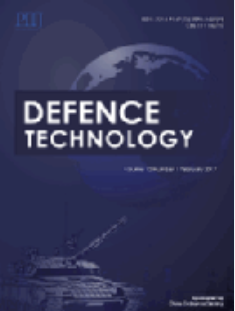Impact-induced energy release of typical HCP metal/PTFE/W reactive materials: Experimental study and predictive modeling via machine learning
IF 5.9
Q1 ENGINEERING, MULTIDISCIPLINARY
引用次数: 0
Abstract
Zirconium, titanium, and other hexagonally close-packed (HCP) metals and their alloys are representative high specific strength, high reaction enthalpy, and high thermal conductivity structural materials. In this study, two typical HCP metals, zirconium, and titanium, were applied to reactive materials (RMs) to prepare Zr/PTFE/W RMs and Ti/PTFE/W RMs, validating the feasibility of HCP metal/PTFE/W RMs. The impact response process of typical HCP metal/PTFE/W RMs under high-velocity dynamic loads was studied using shock equations of state (EOS) based on porous mixtures and chemical reaction kinetics equations. An improved hemispherical quasi-sealed test chamber was employed to measure the energy release characteristic curves of 10 types of Zr/PTFE/W RMs and Ti/PTFE/W RMs under impact velocities ranging from 500 m/s to 1300 m/s. The datasets of the impact-induced energy release characteristics of HCP metal/PTFE/W RMs were established. Additionally, the energy release efficiency of HCP metal/PTFE/W RMs under impact was predicted using the support vector regression (SVR) kernel function model. The datasets of Zr/PTFE/W RMs and Ti/PTFE/W RMs with W contents of 0%, 25%, 50%, and 75% were used as test sets, respectively. The model predictions showed a high degree of agreement with the experimental data, with mean absolute errors (MAE) of 4.8, 6.5, 4.6, and 4.1, respectively.
典型HCP金属/聚四氟乙烯/钨反应材料的冲击诱导能量释放:实验研究和机器学习预测模型
锆、钛等六方密排(HCP)金属及其合金是具有代表性的高比强度、高反应焓、高导热的结构材料。本研究将两种典型的HCP金属锆和钛分别应用于反应材料(RMs)制备了Zr/PTFE/W RMs和Ti/PTFE/W RMs,验证了HCP金属/PTFE/W RMs的可行性。采用基于多孔混合物的冲击状态方程和化学反应动力学方程,研究了典型HCP金属/聚四氟乙烯/钨合金在高速动载荷作用下的冲击响应过程。采用改进的半球形准密封试验箱,测量了10种Zr/PTFE/W RMs和Ti/PTFE/W RMs在500 ~ 1300 m/s冲击速度下的能量释放特性曲线。建立了HCP金属/PTFE/W RMs的冲击诱导能量释放特性数据集。利用支持向量回归(SVR)核函数模型预测了HCP金属/聚四氟乙烯/钨材料在冲击作用下的能量释放效率。分别以W含量为0%、25%、50%和75%的Zr/PTFE/W均方根和Ti/PTFE/W均方根数据集作为测试集。模型预测结果与实验数据高度吻合,平均绝对误差(MAE)分别为4.8、6.5、4.6和4.1。
本文章由计算机程序翻译,如有差异,请以英文原文为准。
求助全文
约1分钟内获得全文
求助全文
来源期刊

Defence Technology(防务技术)
Mechanical Engineering, Control and Systems Engineering, Industrial and Manufacturing Engineering
CiteScore
8.70
自引率
0.00%
发文量
728
审稿时长
25 days
期刊介绍:
Defence Technology, a peer reviewed journal, is published monthly and aims to become the best international academic exchange platform for the research related to defence technology. It publishes original research papers having direct bearing on defence, with a balanced coverage on analytical, experimental, numerical simulation and applied investigations. It covers various disciplines of science, technology and engineering.
 求助内容:
求助内容: 应助结果提醒方式:
应助结果提醒方式:


